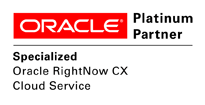Upcoming Event: Mar 24, 2026
Join us at Oracle AI World Tour London 2026
1 min read
Oracle recently announced that the February 2015 version of Service Cloud is available and as always, the new release is packed full of new features and improvements.
In this post, we are going to briefly outline what we feel are the key developments in the February 2015 release that will help your organisation enhance its Customer Experience through Oracle Service Cloud.
By selecting a new option on the messages tab, it is now possible to save a draft incident response without sending it, allowing agents more flexibility when responding to customers. Response text is copied to the committed threads panel upon saving, but it is still possible to edit the thread before sending.
Over time, many incidents will be created, most of these will have associated responses and attachments, which could possibly lead to performance issues.To avoid these issues, Oracle has created an auto-archive feature that will archive incidents that are a certain period of time past their solved date. This period of time is configurable through a configuration setting. There is also an option to permanently delete archived incidents on a Service Cloud instance.
When an incident is archived, it is removed from the database and stored in a searchable file, in a read-only format.
When an SLA instance is added to an incident, you will no longer have to manually calculate the resolution due date. New tables have been added to the database, allowing users to create custom reports to expose such data.
Fig. 1 Custom reports can be created to include the due date for resolution based on the applied SLA instance.
In the February 2015 release, several features have been added in order to make customising the content of administrator notifications, administrator emails and contact emails more efficient:
Private messaging support for Facebook channels has been added to the Social Monitor component of Service Cloud, allowing customers to update incidents with non-public information via the Facebook channel. Incidents will be updated with both public and private customer replies, giving agents a full view of the conversation in the incident response thread.
The November 2014 release of Service Cloud announced an enhanced co-browse capability, with enhanced browser and platform support, as well as one-click co-browse launching.
The February 2015 release of Service Cloud delivers further enhancements, adding support for mobile and tablet devices.
For companies that require advanced security compliance (PCI/DISA), this release brings a new level of security to the past session timeout features, forcing users to re-authenticate after a predefined period of time. This functionality can be set using a new configuration setting (SESSION_HARD_TIMEOUT).
By configuring session timeouts in this fashion, users will be alerted 5 minutes before their session is set to expire. After re-entering login details, users will be authenticated and a new session will be created.
The Add-In Manager has been upgraded in the February 2015 release to make it safer for sites with add-ins to upgrade. The changes prevent customers from deleting add-ins during the upgrade cycle. However, they will still have the ability to modify add-in permissions and upload any updates to existing add-ins.
February 2015 marks another successful quarterly release for Oracle Service Cloud, with the features described above, alongside smaller developments, combining to give a more complete customer service solution.
If you are a currently a Service Cloud customer and you are on Oracle’s auto-upgrade program, you can expect to be contacted very soon about upgrading your instance.
If you would like more information around Service Cloud and how it can help enhance your customers experience, why not contact us, or call us now on +44 203  2834315, to discuss how your organisation can benefit from using a customer experience focused application such as Oracle Service Cloud.
2834315, to discuss how your organisation can benefit from using a customer experience focused application such as Oracle Service Cloud.
Boxfusion Consulting are a Specialised Oracle Service Cloud Implementation partner.
1 min read
1 min read
Join us to experience the future of AI and Cloud!
2 min read